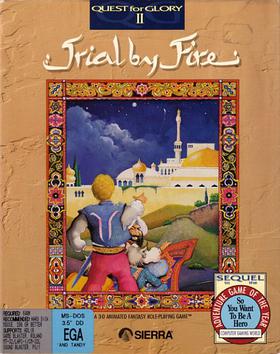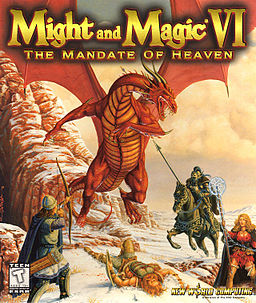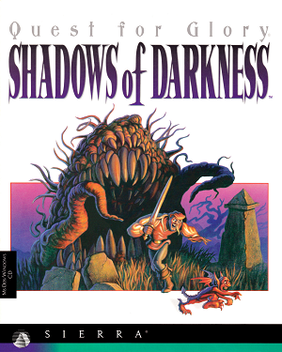
Quest for Glory is a series of hybrid adventure/role-playing video games, which were designed by Corey and Lori Ann Cole. The series was created in the Sierra Creative Interpreter, a toolset developed at Sierra specifically to assist with adventure game development. The series combines humor, puzzle elements, themes and characters borrowed from various legends, puns, and memorable characters, creating a 5-part series in the Sierra stable.

Space Quest is a series of six comic science fiction adventure games released between 1986 and 1995. The games follow the adventures of a hapless janitor named Roger Wilco, who campaigns through the galaxy for "truth, justice, and really clean floors".
Mark Seibert is an American musician, composer, and producer best known for his work on various video games from Sierra Entertainment.

Quest for Glory II: Trial by Fire is the second video game in Sierra On-Line's Quest for Glory series, and the sequel to Hero's Quest: So You Want to Be a Hero.
Warlords is a video game series created by Steve Fawkner, in which role-playing elements are combined with turn-based strategy in a fantasy setting. The series began with Warlords in 1990 and includes three other games, two expansion packs, and several spinoffs.
AGD Interactive (AGDI), LLC. is a non-profit company given a fan license to remake Sierra Entertainment's popular classic adventure games from the 1980s and early 1990s.

The Bard's Tale III: Thief of Fate is a computer fantasy role-playing video game created by Interplay Productions in 1988. It is the second sequel to The Bard's Tale. It was designed by Rebecca Heineman, Bruce Schlickbernd, and Michael A. Stackpole. The game was released for the Amiga, Apple II (64k), Commodore 64, and DOS.

Might and Magic VI: The Mandate of Heaven, commonly abbreviated to Might and Magic VI or simply MM6, is a role-playing video game developed by New World Computing and published by 3DO in 1998. It is the sixth installment in the Might and Magic series, the sequel to Might and Magic V: Darkside of Xeen and the first of the Might and Magic titles to take place on the same planet as Heroes of Might and Magic. It continues the storyline of Heroes of Might and Magic II, and takes place at the same time as Heroes of Might and Magic III in the series chronology. The game was compared favorably to its peers, role-playing video games such as The Elder Scrolls II: Daggerfall. Critics praised it for its non-linear, user-friendly premise, an interactive, detailed game world and a polished, bug-free initial release. A Limited Edition version of the game was also released, including a cloth map of Enroth, a strategy guide and the first five games of the series on CD-ROM. It was followed by three sequels, with Might and Magic VII: For Blood and Honor directly continuing the story arc.

King's Quest IV: The Perils of Rosella is a graphic adventure game developed and released by Sierra On-Line for the MS-DOS, Amiga, Apple II, Apple IIGS, and Atari ST computers in 1988. The player takes on the role of Princess Rosella, daughter of King Graham of Daventry and the twin sister of Gwydion/Alexander, who must save her father and a good fairy and destroy an evil witch. Critically acclaimed, it was one of the first PC games to support a sound card.

King's Quest V: Absence Makes the Heart Go Yonder! is a 1990 graphic adventure game by Sierra On-Line. Originally released in November 1990, it featured a significant improvement in graphics. It was also the first King's Quest installment to replace the typing user interface with a point-and-click user interface. The title is a spoof on the proverb "Absence makes the heart grow fonder".

The Coles is a colloquial term referring to Corey Cole and Lori Ann Cole, a husband and wife team who are both video game designers. Working together they designed the Quest for Glory series. They have also each designed games independently.

Roberta Williams' Mixed-Up Mother Goose is a computer game first released by Sierra On-Line in 1987. It is, in essence, an edutainment title, directed specifically at young gamers, as well as an adventure game. It was the first multimedia game released on CD-ROM in 1991. A second game in the series, Mixed-Up Fairy Tales, was released in 1991.

Leisure Suit Larry 6: Shape Up or Slip Out! is the fifth entry in the Leisure Suit Larry series of graphical adventure games published by Sierra On-Line and is a sequel to the 1991 video game, Leisure Suit Larry 5: Passionate Patti Does a Little Undercover Work. Originally developed for MS-DOS in 1993, an enhanced CD-ROM version was published a year later.

Leisure Suit Larry in the Land of the Lounge Lizards is a graphic adventure game, developed by Sierra On-Line, and published in 1987. It was developed for the PC, DOS, and the Apple II and later ported to other platforms, such as the Amiga, Atari ST, Apple IIGS, Macintosh, and Tandy Color Computer 3. It utilizes the Adventure Game Interpreter (AGI) engine. In 1991, Sierra released a remake titled Leisure Suit Larry 1: In the Land of the Lounge Lizards for PC DOS, Apple Macintosh, and Amiga. This version used the Sierra's Creative Interpreter (SCI) engine, featuring 256 colors and a point-and-click, icon-driven user interface.

Quest for Glory V: Dragon Fire is the fifth and final game in the Quest for Glory computer game series by Sierra FX, a former "sub brand" of Sierra On-Line. Unlike the first four games, Dragon Fire is primarily an action role-playing game with some elements of graphical adventure.

Quest for Glory: Shadows of Darkness is an adventure game/role-playing video game hybrid. It is the fourth installment of the Quest for Glory computer game series by Sierra On-Line. It was the first and only game of the series to drop the numerals from the title.

Quest for Glory: So You Want to Be a Hero is a 1989 adventure game/role-playing game hybrid, designed by Lori Ann Cole and published by Sierra On-Line for MS-DOS. It is the first game in the Quest for Glory series, and has been credited for being a genre-defining game, as it tried to mix graphical adventure gaming with role-playing-like elements such as statistic building that would actually affect the ability to accomplish certain parts of the game. The game has a satirical and silly tone. Ports for the Amiga, Atari ST, and NEC PC-9801 were released in the early 1990s. A VGA remake, titled Quest for Glory I: So You Want to Be a Hero, was released in 1992 for DOS and later in 1994 for Mac OS.

Space Quest: Chapter I – The Sarien Encounter is a graphic adventure game, created by Scott Murphy and Mark Crowe, and released in October 1986 by Sierra On-Line. It is the first game in the Space Quest series, and sees players assume the role of a lowly janitor on a research ship, who becomes involved in stopping an alien race using a new form of technology for evil purposes.

Space Quest III: The Pirates of Pestulon is a 1989 graphic adventure game by Sierra On-Line, and the third game in the Space Quest series. Players assume the role of Roger Wilco, a lowly space janitor, who becomes involved in rescuing a pair of computer programmers from a sinister video game company. The game received positive reviews from critics, and contributed further to the series' commercial success for Sierra. A sequel, Space Quest IV, was released in 1991.

Police Quest: In Pursuit of the Death Angel is a 1987 police procedural adventure video game developed and published by Jim Walls and Sierra On-Line. Police Quest follows police officer Sonny Bonds as he investigates a drug cartel in the town of Lytton, California.



















